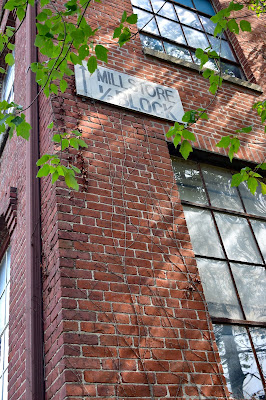From Dave Brigham:
Up until this month, on the rare occasions when I thought about Stafford Springs, Conn., I imagined the stock-car track there. That's it. But when I looked at Google Maps recently and realized that this village in the town of Stafford has 19th-century mills and commercial buildings of the same era, I knew I had to find out more.
Regular readers will recall that of late I have explored former (and, in some cases, still somewhat current) mill towns on the route between my house outside Boston and my mother's home in Connecticut. To date, I have tromped through the Rockville area of Vernon, Conn., (see April 24, 2021, "Zooming Through Loom City, Part I: The Mills" and April 30, 2021, "Zooming Through Loom City, Part II: Other Than the Mills"); and Southbridge, Mass., (see July 30, 2021, "Keeping an Eye on Southbridge, Mass. (Part I)" and August 18, 2021, "Keeping an Eye on Southbridge, Mass. (Part II)."
Incorporated in 1719, Stafford initially was, like most towns in New England, a farming community. The Industrial Revolution brought mills to the town, especially to Stafford Springs, which sits astride the Willimantic River. By the mid-1800s, a railroad connected the town to the rest of New England, and a trolley ran to the aforementioned Rockville.
One of the mill complexes that still stands in this north-central Nutmeg State town rose in 1853 as the Converseville Company, according to this fantastic Hartford Courant article that I relied on heavily for this post.






(Now part of the American Woolen Company, the buildings in the above photos have been home to a variety of mill operations over the past 168 years.)
Located along Furnace Avenue in the heart of the village, the mill complex is still known to many as, and has signage for, the Warren Woolen Company.


"In 1879, [Parley] Converse sold the textile manufacturing company to brothers Daniel and Thomas Warren, who would rename it the Warren Woolen Company," according to the Courant article. "In 1890, it was acquired by J. M. Valentine and would continue to be operated by him and subsequent family members almost uninterrupted for the next 80 years. In 1978, the mill was acquired by Joseph Anderer and the name changed to Warren Corporation. The well-known Italian clothing company Loro Piana purchased the mill in 1988, but difficult economic times and competition from abroad forced the company to close its doors in the spring of 2014."




I'm amazed that these mills were in continuous operation from before the Civil War until the year that a robotic spacecraft landed on the Agilkia comet. And part of that time by an Italian clothing company! But the story doesn't end there.
In June 2014, "Jacob Long of American Woolen Company purchased the mill and reopened its doors once more," according to the Courant article. "The mill remains the only Connecticut firm which still manufactures woolen cloth using the entire process from raw wool to finished product."
That's pretty cool.
I also shot photos of another former mill downtown.


The former B.P. Cooley Mill faces River Road; its backside overlooks the railroad tracks. Now home to businesses including a town-run thrift shop, a dance studio, a book store and several artist studios, the old mill building dates to 1875. William Smith & Co. was the original occupant, according to this wonderful history from Preservation Connecticut. From the 1870s until the 1930s, the company was known as Smith and Cooley, manufacturing woolen products. Buildings were added over the decades. Benjamin P. Cooley acquired the company in 1936 and reorganized it as B.P. Cooley Co. There were other ownership changes until the wool company went out of business in 2002. In 2005, a town resident acquired the building from an outfit that had used the mill to reprocess wool for clients such as the baseball manufacturer, Rawlings, according to this Journal Inquirer article.
There's a cool mix of old details and funky new artistic ones around the complex.




That wraps up a few mills in Stafford Springs. Stay tuned for a future article about more of the downtown shops, parks, statues and more, as well a post about the nearby race track.

Thank you for such a great article about downtown Stafford!
ReplyDeleteMy pleasure! Glad you enjoyed it.
DeleteYour article was great. I lived in Stafford for most of my life. I can still hear the "click clack "of the mills as we walked by. Also remembering watching the women on the many looms. Hope to return some day. Nothing like living in Stafford.
ReplyDeleteThanks! Glad you enjoyed it
DeleteI worked on warrens Mills roofs for years a lot of building there
ReplyDelete